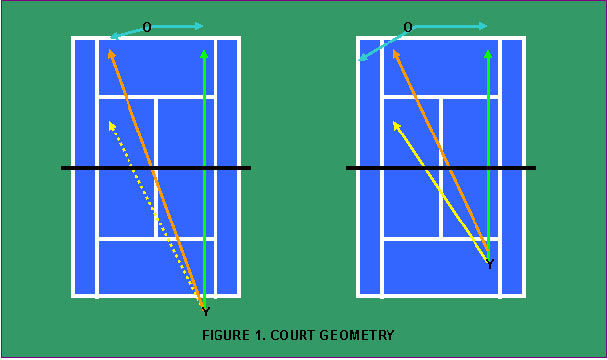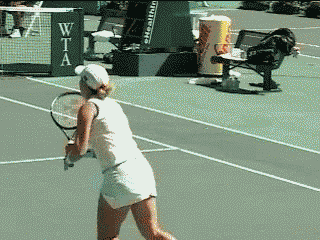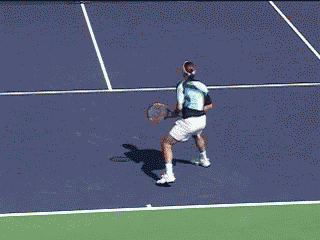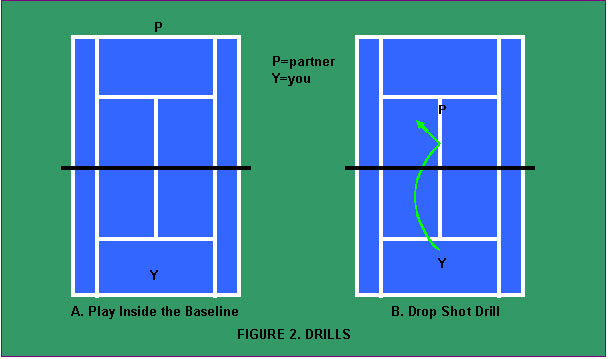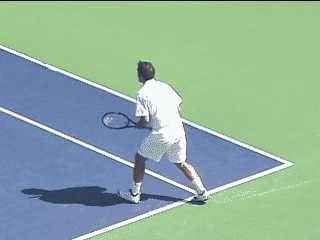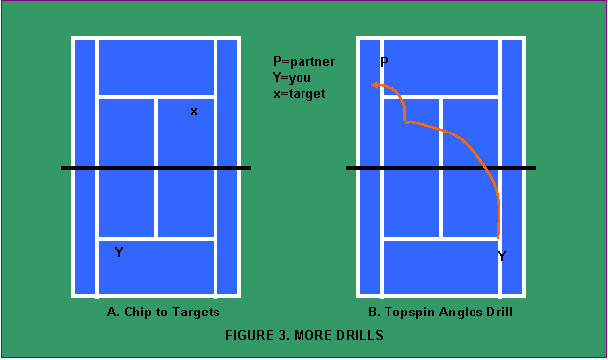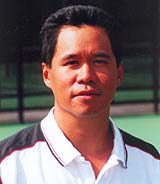|
TennisOne Lessons Open the Court with Deep-Short Combinations Doug Eng EdD, PhD When we think of good baseline rallies, we think of deep topspin drives. The average junior or club player will try to out-rally an opponent by hitting deep. On the WTA tour, we see many pros try to drive through their opponents with relatively flat, powerful groundstrokes. When we hit deep groundstrokes, many players feel rhythm in their comfort zone. But what feels good is not always good so to speak. Too many players never really try to develop more advanced tactics besides hitting deep groundstrokes. Driving the ball deep down-the-line or crosscourt doesn’t fully utilize the court. Sometimes we see incredibly long rallies (as with high school girls) where the ball is consistently hit deep down the center of the court. Neither player understands how to close out the point. Some players will try to hit the ball harder to produce winners but instead, they just make more errors. There are several ways to close out points: step in and hit winners, approach the net for a winning volley or overhead, or bring the opponent to the net and pass her. A final way is using shot combinations that open the court. Although net play is a preferred offense, let’s take a look at a baseline tactic that move beyond neutral rallies – the deep-short combination.
Court Geometry You might have heard the expression, "tennis is a crosscourt game."
The expression refers to the geometry of the court with the diagonal being the longest and safest place to aim. Figure 1 shows the court geometry and general In general, if you (“Y” at the bottom of the left court) are behind the baseline, you may have two choices of shots: the down-the-line (green line) and the crosscourt (orange line). A third option would be a short angle (yellow dotted line) but from that position (behind the baseline), it would be a fairly difficult shot to hit. If you stand inside the baseline (“Y” at the bottom of the right court), you again have the first two options, but your third option of the angle (yellow solid line) becomes easier to play.
Basically, I am illustrating a fact most of us understand: you have more offensive shot options the closer you are to the net. For example, drop shots are easier to play from inside the baseline. Volleys and overheads are also easier to play inside the baseline.
In Figure 1 (right), your opponent (“O” at the top of the court) has to cover more court when you are inside the baseline. The blue lines denote how much your opponent might have to run. Your opponent won’t have to work as hard if you are behind the baseline in the left court. If you are inside the baseline, not only does your opponent have to cover more court but it becomes harder for your opponent to anticipate your shot. Given your opponent may have to run more and can’t anticipate as well, your chances of winning the point dramatically increase. Deep-Short Combinations Figure 1 (right) shows how you can make your opponent run hard if you are inside the baseline. But how can you make your opponent hit short to set you up? The most basic pattern is hitting deep shots that force your opponent to cough up a short ball. So now you have options to attack the short ball. But taking advantage of a short ball isn’t easy for some players who lack feel for the ball. So when their opponent hits short, they can only drive the ball deep again. If they go to the net, they may be able to end the point. But if they don’t go to the net, the point often continues and the cycle starts over again. Even if they go to the net, many baseliners are not comfortable volleying and get passed. So, most baseliners need to develop mid-court options which are deep-short combinations. These combinations create a bigger court for an opponent and allows the player to end the point, given the right opportunity. Let’s go over a few of these.
Patterns Deep Drive, Drop Shot: One of the most well-known combinations relies on driving your opponent well behind the baseline or past the doubles alley. If your opponent hits a slightly short ball, you can go to the opposite half of the court with a drop shot. If you play on clay courts, you may find this combination very useful. Deep Down-the-Line, Crosscourt Topspin Angle: After a great down-the-line, if your opponent has to run hard, often your opponent will play a down-the-line back or a ball to the middle. In either case, if you take pace off and roll the ball crosscourt to the open court, you have a winner. Deep Crosscourt, Short Crosscourt: This great combination works against speedy players. If you and your opponent just exchanged crosscourts, hit another crosscourt, shorter and with more angle. Often your speedy opponent is recovering and running back into the court. Hitting behind your opponent with a better angle is often a winner. If your opponent is slow, a short angle forces him to move up and past the doubles alley. Deep Drive, Slice Crosscourt Angle: This combination is similar to the second and third combination above as it forces opponents to run forward and wide. Against an opponent with a western forehand grip or a double-handed backhand, the slice keeps the ball low and uncomfortable. Roger Federer uses this combination often to open the court. Deep Loop, Short Slice: This isn’t really a winning combination but it takes rhythm away from an opponent who is steady at the baseline. It is a bit harder to play as it involves more skills. The loop is a heavy, high topspin drive which bounces high and is uncomfortable for many. Adding a slice again keeps the ball out of the strike zone. The idea is keep your opponent uncomfortable.
Deep Crosscourt, Short Down-the-Line: This is an underrated combination but occurs more often than we think. After hitting a great crosscourt, often we think ripping a down-the-line ends the point. However, defenders often run to the ball along the baseline. A craftier approach after a great crosscourt, is just the roll the ball down-the-line. Taking pace off the ball allows it to dip low around the baseline where most opponents like to run along. It is amazing how often it works since most opponents anticipate a ball that is ripped through to the baseline. Taking off pace gives no second chances for an opponent who gets to the ball on the second bounce. Skills and Drills to Practice Deep-short tactics don’t involve getting to the net but they offer the baseliner alternate ways of ending points. They do, however, require some skills worth practicing. Basically you need good touch, the ability to play a short slice, drop, or chip and to roll the ball with topspin. Let’s go over some skills and drills routines.
Closing Comments Keep in mind that baseline play is not about just hitting deep groundstrokes. When the opportunity arises, step in and make the court bigger for your opponent. Practice opening up the court with angled balls and short balls. You may find yourself playing smarter and winning more often. Your comments are welcome. Let us know what you think about Doug Eng's article by emailing us here at TennisOne.
Doug Eng EdD PhD coaches men's tennis at Tufts University. During the summer, he directs at the Tennis Academy at Harvard. He has received four divisional Pro of the Year honors from the PTR and USPTA and several national awards including PTR Tester of the Year. Doug is a member of the USTA National Sport Science Committee. He completed the USTA High Performance Coaches program and frequently runs educational and training programs for coaches. |
